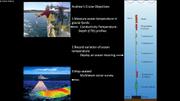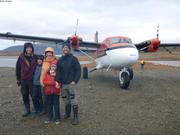Talbot Inlet
It's a real relief for the entire crew: the shelter behind Easter Island, in Talbot Inlet, is good. We stay there for 2 nights during a gale from southeast. Taking advantage of lulls, we try from the south to reach Wykeham and Trinity, objects of our mission. These glaciers are the two largest icebergs producers in Canada. So we explore the narrow and shallow passage between Easter Island and Ellesmere Island, which meanders between two more quiet glaciers. Superb, but at the exit of the passage the ice holds us and eventually break the sonar arm! Nevertheless, bathymetry continues with Vagabond's echo sounder (single-beam).
We find our way through the ice coming from the east and manage to deploy the complete oceanographic mooring that Andrew has been looking to install in Talbot Inlet for 4 years, with the Amundsen icebreaker. Certainly Vagabond can venture more freely in uncharted waters, and maneuver more easily between large icebergs and ice floes that constantly clutter the bay.
Still impossible to reach our two glaciers, but we manage to prove that there is no sill between Talbot Inlet and the Nares Strait, so there is a high probability that Atlantic waters will go up to Wykeham and Trinity glaciers fronts. We need about 10 hours of ice navigation to perform two series of hydrographic surveys (CTD transects), north-south and east-west. For Andrew, the essential is done.
Everything is so calm that you can hear the breath of the bear. Met one hour earlier, out of the mist, he found us on the other side of the large ice floe, while Vagabond is stopped during the dinner break. The bear is very close, just a small lead of water separates us, we watch him for long time. The next day, at anchor in Cadogan Bay, I spot a bear swimming towards Vagabond. He ends up turning around and goes back to shore. These encounters are always fascinating.
Andrew must join his family as soon as possible but the weather is not good and the Twin Otter (small plane) can not pick him up near Cape Isabella. So, before heading south, he enjoys with us the very good conditions for a series of CTDs in Cadogan Inlet, which might be the thickest glacier in Canada.
Two days of nonstop and a little rough navigation to Dundas Harbour, south of Devon Island, and Andrew is finally picked up by a Twin Otter, less than 2 hours after our arrival.
We learn then that the remains of a Russian rocket fell exactly on our way, a few hours after our passage!


